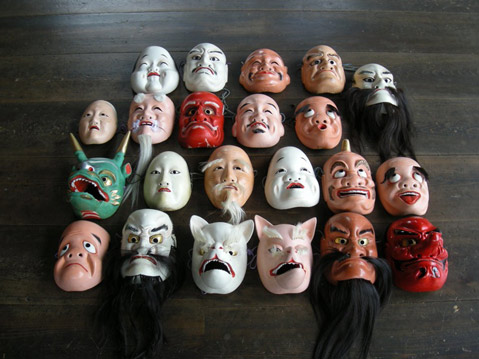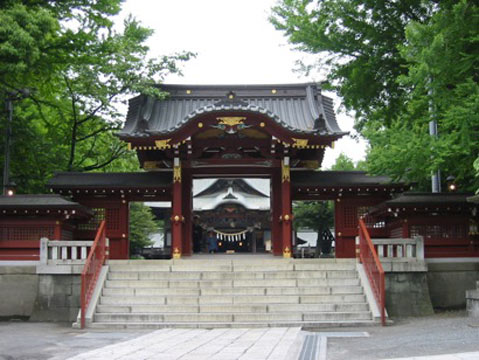
Deep beneath the sea off the coast of Japan, the earth began to quake. The ocean above it swelled in response, rising into a giant wave that cast a dark shadow over the land.
It sounds like the beginning of an epic legend, but this is a true story. The Great East Japan Earthquake of March 11, 2011, was the largest seismic event ever to hit the country, and the tsunami’s devastation left more than 15,000 dead. In the wake of the disaster, the international community rushed to Japan’s aid, and in subsequent weeks, the world watched as — with remarkable patience and harmony — the rebuilding process began.

For centuries, the Japanese have told tales of disaster and recovery through sacred dance and music. Such tales are central to Shinto, an ancient Japanese spiritual tradition that blends folklore, history, and mythology. This Saturday, November 3, Santa Barbarans have a rare opportunity to witness these sacred arts when UCSB hosts a ritual dance ensemble from a major Shinto shrine near Tokyo.
This event marks the first time the Kagura Ensemble of Chichibu Shrine has ever performed in the United States, and their Santa Barbara stop is their only appearance. The group comes to town courtesy of the International Shinto Foundation (ISF), an organization that supports teaching and research on Japanese culture. Professor Fabio Rambelli, chair of the Department of East Asian Languages and Cultural Studies at UCSB, also holds the ISF Endowed Chair of Shinto Studies. This Saturday, Rambelli will host an international symposium: The Sacred and Natural Disasters, honoring those lost in the Tohoku quake and featuring performances by the Chichibu Shrine artists. That evening at 8 p.m., the ensemble will give a public performance at UCSB’s MultiCultural Center Theater.
Kagura is a specific type of Japanese ritualistic dance whose roots are thought to predate Noh theater. Though there are many regional variations, kagura typically incorporates hand-painted, carved wooden masks and elaborate costumes. Unlike Japanese folk dance, kagura performances are understood as religious events. “Kagura dance and music can be traced back to the very origin of Japanese performing arts,” Rambelli explained in a recent interview. “It is an essential component of today’s ceremonies at Shinto shrines all over Japan. The Chichibu Shrine Kagura Ensemble comes from one of the most important Shinto shrines in Japan, and carries on a continuous performing tradition dating back more than three centuries.”
Though the music and dances the Chichibu ensemble will present are rooted in ancient traditions, they’re far from musty and archaic. “Like many other genres of traditional Japanese performing arts, Kagura preserves some archaic elements combined with astonishingly modern elements, such as obsessive rhythms, minimal melodies, use of dissonances, and hypnotic and rarefied dancing,” Rambelli noted.

The leader of the Ensemble is Minoru Sonoda, head priest of Chichibu Shrine and professor emeritus of Kyoto University. Responding to questions via email (with responses translated by Rambelli), Sonoda explained that the dancers aren’t strictly professionals; they are volunteers who have mastered the forms over years of practice. “Anyone who is interested can become a member of the Kagura ensemble of the shrine,” Sonoda wrote, “However, women are not allowed to join. I personally have no objections to admitting women as well, but traditionally, Kagura performers have always been men.”
Yet not just any man can become a Kagura master, Sonoda explained. “One must first learn the music for Kagura, called hayashi, which is played by a large drum (ohdaiko), a small drum (odaiko), and a flute (fue),” he wrote. “It is very important for the performers to learn the rhythm of Kagura through their body.”
At the Chichibu Shrine, these dances are performed seven times a year, according to such seasonal festivals as the New Year, the arrival of spring, the rice planting, and the harvest. They are danced in the shrine’s Kagura Hall for an audience of community members and visitors. Occasionally, Chichibu Kagura tours to other communities; since being designated by the Japanese government as an “important intangible folkloric cultural property,” they have traveled throughout Japan and performed in Oslo, London, and Rome.
In Santa Barbara, the group will perform excerpts from a traditional Shinto myth known as “Opening of the Heavenly Cave.” Describing the story, Sonoda wrote, “Because the sun goddess [and central Shinto deity] Amaterasu no Ohmikami hid herself in a cave, the world was plunged into darkness. Then, the god Yagokoro-omoikane [the main deity worshiped at Chichibu Shrine] took the lead among the deities to find a way to solve the situation. As a result, the goddess Ame no Uzume purified the world by sprinkling it with hot water, and the powerful god Dajikarao opened up the entrance to the cave and brought back the sun goddess; in this way, light returned to the world.”
To the western imagination, it may seem like a stretch to credit the arts with a nation’s recovery from natural disaster, but that’s exactly what Sonoda suggests. “Japanese traditional performing arts include many sacred dances dedicated to the pacification of the souls of the deceased, reconstruction after a natural disaster, and prayers expressing hope in a new beginning,” he explained. “The region of Japan mostly affected by the earthquake and the tsunami is considered the treasure box of traditional performing arts, and the great energy people in those areas are now putting at the service of the enormous reconstruction effort also comes from strong human relations fostered in close contact with traditional arts.”
And it should be no mystery why this performance is relevant to a Santa Barbara audience. “California is also a region frequently hit by earthquakes,” Sonoda pointed out. “We hope to show how the Japanese recovered after this great disaster.”
4•1•1
A public symposium on The Sacred and Natural Disasters will take place on Saturday, November 3, from 9 a.m.-1:15 p.m. at UCSB’s McCune Conference Room, HSSB 6F. To learn more, visit Shinto.org/isf. The Kagura Ensemble of Chichibu Shrine will perform An Evening of Sacred Music and Dances from Japan at UCSB’s MultiCultural Center Theater on Saturday, November 3, at 8 p.m. For tickets, call 893-2064 or visit mcc.sa.ucsb.edu.



